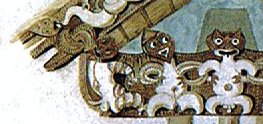The 'humpback'
glyphs occur in
the 23-24th
(respectively
in the 21-22nd)
periods:
|
22 |
 |
 |
 |
 |
|
20 |
 |
 |
 |
 |
|
23 |
 |
 |
- |
 |
|
Ga6-9 |
Ga6-10 |
Ga6-11 |
|
21 |
- |
 |
 |
 |
|
Kb2-111 |
Kb2-112 |
Kb2-113 |
|
24 |
 |
 |
 |
 |
- |
 |
|
Ga6-12 |
Ga6-13 |
Ga6-14 |
Ga6-15 |
Ga6-16 |
|
22 |
 |
 |
 |
 |
 |
 |
|
Kb3-1 |
Kb3-2 |
Kb3-3 |
Kb3-4 |
Kb3-5 |
Kb3-6 |
|
25 |
 |
 |
|
23 |
 |
 |
Earlier (in the
Translations) we
have counted and
commented:
| 21 |
 |
 |
 |
| Kb2-111 |
Kb2-112 |
Kb2-113 |
| *Kb2-16 |
*Kb2-17 |
*Kb2-18 |
| *75 |
*76 |
*77 |
| 22 |
 |
 |
 |
 |
 |
 |
| Kb3-1 |
Kb3-2 |
Kb3-3 |
Kb3-4 |
Kb3-5 |
Kb3-6 |
| *78 |
*79 |
*80 |
*81 |
*82 |
*83 |
| 23 |
 |
 |
| Kb3-7 |
Kb3-8 |
| *84 |
*85 |
At the beginning of line b3 the accumulated glyph ordinal number in the calendar has reached *78, which possibly is significant because 6 * 13 = 78. On the other hand, there is no maro (signifying 'end') in Kb2-113. The strange tu'a appendage in Kb3-4 certainly connects the glyph to Kb2-111 in the previous period. Periods 21 and 22 belong together.
In Kb3-7 (at the well known number 84) there are maro, one at left and one at right, probably alluding to the double henua in Kb3-8.
Period 21 seems to be connected with period 22, while period 23 evidently is the end period of a grand season, thereby connecting backwards to period 17 (as we have seen):
| 17 |
3 |
*29 |
*85 |
| 18, 19, 20 |
*7 + 4 + 4 = *15 |
*26 |
| 21, 22, 23 |
3 + 6 + 2 = 11 |
The length of the grand season is *29 glyphs (associating to the number of nights in a month - including the dark night).
The 59th glyph in the calendar is the end glyph in period 17 (Kb1-104). From Kb1-104 to Kb3-8 (the 85th glyph) there are 26 glyphs. Period 17 (the vero period), therefore, seems to be in a way isolated from the following periods. What we can read from the glyphs agrees with the number structure imagined - at least so far. 29 should be separated into 3 + 26 ...
|
Furthermore:
...
Presumably
the
end
glyph
in
period
23
is
meant
to
be
read
together
with
Kb1-104.
Kb1-104
has
a
'knee'
bent
upwards,
while
the
leg
in
Kb3-8
is
oppositely
oriented:
|
17 |

|
23 |

|
|
Kb1-104 |
Kb3-8 |
|
*58 |
*59 |
25 |
*84 |
Kb1-104
is
the
59th
(as
reconstructed
by
me)
glyph
of
the
calendar,
as
if
it
was
the
last
night
of a
synodic
double-month,
while
Kb3-8
is
the
84th
glyph,
also
a
number
we
recognize
and
-
hopefully
-
will
soon
understand
better.
The
mirrored
legs
in
the
pair
Kb1-104
and
Kb3-8
(6
periods
apart)
presumably
indicate
beginning
and
end
of a
major
season
(autumn?).
With
Kb1-101
(at
the
end
of
period
13)
in
memory,
the
season
in
question
probably
begins
with
Kb1-105
in
period
18.
If
so,
then
the
measure
of
the
season
perhaps
is
24
(instead
of
25)
glyphs.
On
the
other
hand,
Kb3-8
is
the
26th
glyph
beyond
Kb1-104.
The
concept
of
mirrored
legs
determining
a
season
give
us
reason
to
also
consider
the
mirrored
arms
in
the
end
glyphs
11
and
20:
|
11 |

|
20 |

|
|
Ka5-10 |
Kb2-110 |
|
32 |
33 |
*40 |
*73 |
Although
the
arms
are
nearly
straight,
the
arm
in
Ka5-10
is
slightly
convex
upwards
and
the
arm
in
Kb2-110
slightly
convex
downwards.
Up
comes
before
down,
both
in
arms
and
legs.
Here
we
immediately
can
understand
why
the
arms
in
the
pair
of
glyphs
have
been
designed
as
markers
- 20
is
the
natural
counting
end
(twice
10)
while
11
is
the
beginning
of
the
2nd
counting
beyond
10
... |
Here we must
note the
similarity in
leg form:
|
21 |
23 |
 |

|
|
Kb2-111 |
Kb3-8 |
|
*Kb2-16 |
*84 |
|
*75 |
The triplet of
periods (21-23)
is beginning
with the
'humpback' and
finished with
number *84.
The mago
glyphs probably
suggest the
waxing period
(when there is
much eating and
growing), and
then we expect a
mirror season to
follow, which later
will turn into the
'ghostly'
('empty shell') state:
































